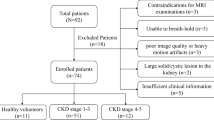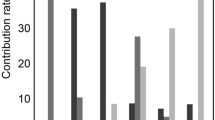Abstract
Introduction
The commonly used clinical indicators are not sensitive and comprehensive enough to evaluate the early staging of chronic kidney disease (CKD). This study aimed to evaluate the differences in arterial spin labeling (ASL) and blood oxygenation level–dependent functional magnetic resonance imaging (BOLD-MRI) parameter values among patients at various stages of chronic kidney disease and healthy individuals.
Methods
Electronic databases PubMed, Web of Science, Cochrane, and Embase were searched from inception to March 29, 2024, to identify relevant studies on ASL and BOLD in CKD. The renal blood flow (RBF) and apparent relaxation rate (R2*) values were obtained from healthy individuals and patients with various stages of CKD. The meta-analysis was conducted using STATA version 12.0. The random-effects model was used to obtain estimates of the effects, and the results were expressed as 95% confidence intervals (CIs) and mean differences (MDs) of continuous variables.
Results
A total of 18 published studies were included in this meta-analysis. The cortical RBF and R2* values and medulla RBF values were considerably distinct between patients with various stages of CKD and healthy controls (MD, − 78.162; 95% CI, − 85.103 to − 71.221; MD, 2.440; 95% CI, 1.843 to 3.037; and MD, − 36.787; 95% CI, − 47.107 to − 26.468, respectively). No obvious difference in medulla R2* values was noted between patients with various stages of CKD and healthy controls (MD, − 1.475; 95% CI, − 4.646 to 1.696).
Conclusion
ASL and BOLD may provide complementary and distinct information regarding renal function and could potentially be used together to gain a more comprehensive understanding of renal physiology.






Similar content being viewed by others
Data availability
Additional data are made available in supplementary document of this manuscript.
References
Aklilu AM (2023) Diagnosis of chronic kidney disease and assessing glomerular filtration rate. Med Clin North Am 107(4):641–658. https://doi.org/10.1016/j.mcna.2023.03.001
Alsop DC, Detre JA, Golay X (2015) Recommended implementation of arterial spin-labeled perfusion MRI for clinical applications: a consensus of the ISMRM perfusion study group and the European consortium for ASL in dementia. Magn Reson Med 73(1):102–116. https://doi.org/10.1002/mrm.25197
Cai YZ, Li ZC, Zuo PL (2017) Diagnostic value of renal perfusion in patients with chronic kidney disease using 3D arterial spin labeling. J Magn Reson Imag : JMRI 46(2):589–594. https://doi.org/10.1002/jmri.25601
Chan WY, Hartono S, Thng CH (2020) New advances in magnetic resonance techniques in abdomen and pelvis. Magn Reson Imag Clin N Am 28(3):433–445. https://doi.org/10.1016/j.mric.2020.04.001
Chen F, Yan H, Yang F (2021) Evaluation of renal tissue oxygenation using blood oxygen level-dependent magnetic resonance imaging in chronic kidney disease. Kidney Blood Press Res 46(4):441–451. https://doi.org/10.1159/000515709
Chen TK, Knicely DH, Grams ME (2019) Chronic kidney disease diagnosis and management: a review. JAMA 322(13):1294–1304. https://doi.org/10.1001/jama.2019.14745
Copur S, Yavuz F, Sag AA (2022) Future of kidney imaging: functional magnetic resonance imaging and kidney disease progression. Eur J Clin Invest 52(5):e13765. https://doi.org/10.1111/eci.13765
Cox EF, Buchanan CE, Bradley CR (2017) Multiparametric renal magnetic resonance imaging: validation, interventions, and alterations in chronic kidney disease. Front Physiol 8:696. https://doi.org/10.3389/fphys.2017.00696
Drawz P, Rahman M (2015) Chronic kidney disease. Ann Inter Med. https://doi.org/10.7326/aitc201506020
Echeverria-Chasco R, Vidorreta M, Aramendía-Vidaurreta V (2021) Optimization of pseudo-continuous arterial spin labeling for renal perfusion imaging. Magn Reson Med 85(3):1507–1521. https://doi.org/10.1002/mrm.28531
Epstein FH (1997) Oxygen and renal metabolism. Kidney Int 51(2):381–385. https://doi.org/10.1038/ki.1997.50
Evans RG, Ince C, Joles JA (2013) Haemodynamic influences on kidney oxygenation: clinical implications of integrative physiology. Clin Exp Pharmacol Physiol 40(2):106–122. https://doi.org/10.1111/1440-1681.12031
Ferré JC, Bannier E, Raoult H (2013) Arterial spin labeling (ASL) perfusion: techniques and clinical use. Diagn Interv Imaging 94(12):1211–1223. https://doi.org/10.1016/j.diii.2013.06.010
Fine LG, Norman JT (2008) Chronic hypoxia as a mechanism of progression of chronic kidney diseases: from hypothesis to novel therapeutics. Kidney Int 74(7):867–872. https://doi.org/10.1038/ki.2008.350
Fine LG, Orphanides C, Norman JT (1998) Progressive renal disease: the chronic hypoxia hypothesis, kidney international. Supplement 65:S74-78
Gillis KA, McComb C, Patel RK (2016) Non-Contrast renal magnetic resonance imaging to assess perfusion and corticomedullary differentiation in health and chronic kidney disease. Nephron 133(3):183–192. https://doi.org/10.1159/000447601
Glassock RJ, Warnock DG, Delanaye P (2017) The global burden of chronic kidney disease: estimates, variability and pitfalls. Nat Rev Nephrol 13(2):104–114. https://doi.org/10.1038/nrneph.2016.163
Hansell P, Welch WJ, Blantz RC (2013) Determinants of kidney oxygen consumption and their relationship to tissue oxygen tension in diabetes and hypertension. Clin Exp Pharmacol Physiol 40(2):123–137. https://doi.org/10.1111/1440-1681.12034
Hutton B, Salanti G, Caldwell DM (2015) The PRISMA extension statement for reporting of systematic reviews incorporating network meta-analyses of health care interventions: checklist and explanations. Ann Intern Med 162(11):777–784. https://doi.org/10.7326/m14-2385
Kannenkeril D, Janka R, Bosch A (2021) Detection of changes in renal blood flow using arterial spin labeling MRI. Am J Nephrol 52(1):69–75. https://doi.org/10.1159/000513665
Ladd ME (2007) High-field-strength magnetic resonance: potential and limits. Topi Magn Reson Imag TMRI 18(2):139–152. https://doi.org/10.1097/RMR.0b013e3180f612b3
Li C, Liu H, Li X (2019) Application of BOLD-MRI in the classification of renal function in chronic kidney disease. Abdominal Radiol (New York) 44(2):604–611. https://doi.org/10.1007/s00261-018-1750-6
Li LP, Tan H, Thacker JM (2017) Evaluation of renal blood flow in chronic kidney disease using arterial spin labeling perfusion magnetic resonance imaging. Kidney Inter Rep 2(1):36–43. https://doi.org/10.1016/j.ekir.2016.09.003
Li X, Li C, Liu H (2020) Revealing the decrease of renal cortical perfusion in primary glomerular disease and renal aging by arterial spin labeling. Iranian J Radiol. https://doi.org/10.5812/iranjradiol.96147
Lindner T, Bolar DS, Achten E (2023) Current state and guidance on arterial spin labeling perfusion MRI in clinical neuroimaging. Magn Reson Med 89(5):2024–2047. https://doi.org/10.1002/mrm.29572
Lu F, Yang J, Yang S (2021) Use of three-dimensional arterial spin labeling to evaluate renal perfusion in patients with chronic kidney disease. J Magn Reson Imag JMRI 54(4):1152–1163. https://doi.org/10.1002/jmri.27609
Mao W, Ding Y, Ding X (2022) Capability of arterial spin labeling and intravoxel incoherent motion diffusion-weighted imaging to detect early kidney injury in chronic kidney disease. Eur Radiol. https://doi.org/10.1007/s00330-022-09331-z
McInnes MDF, Moher D, Thombs BD (2018) Preferred reporting items for a systematic review and meta-analysis of diagnostic test accuracy studies: The PRISMA-DTA statement. JAMA 319(4):388–396. https://doi.org/10.1001/jama.2017.19163
Neugarten J, Golestaneh L (2014) Blood oxygenation level-dependent MRI for assessment of renal oxygenation. Int J Nephrol Renov Dis 7:421–435. https://doi.org/10.2147/ijnrd.S42924
Papageorgakis C, Firippi E, Gy B (2023) Fast WASABI post-processing: access to rapid B(0) and B(1) correction in clinical routine for CEST MRI. Magn Reson Imaging 102:203–211. https://doi.org/10.1016/j.mri.2023.06.001
Parrish AE (1992) Complications of percutaneous renal biopsy: a review of 37 years’ experience. Clin Nephrol 38(3):135–141
Prasad PV, Li LP, Hack B (2023) Quantitative blood oxygenation level dependent magnetic resonance imaging for estimating intra-renal oxygen availability demonstrates kidneys are hypoxemic in human CKD. Kidney int rep 8(5):1057–1067. https://doi.org/10.1016/j.ekir.2023.02.1092
Prasad PV, Li LP, Thacker JM (2019) Cortical perfusion and tubular function as evaluated by magnetic resonance imaging correlates with annual loss in renal function in moderate chronic kidney disease. Am J Nephrol 49(2):114–124. https://doi.org/10.1159/000496161
Prasad PV, Thacker J, Li LP (2015) Multi-parametric evaluation of chronic kidney disease by MRI: a preliminary cross-sectional study. PLoS ONE 10(10):e0139661. https://doi.org/10.1371/journal.pone.0139661
Pruijm M, Milani B, Pivin E (2018) Reduced cortical oxygenation predicts a progressive decline of renal function in patients with chronic kidney disease. Kidney Int 93(4):932–940. https://doi.org/10.1016/j.kint.2017.10.020
Rossi C, Artunc F, Martirosian P (2012) Histogram analysis of renal arterial spin labeling perfusion data reveals differences between volunteers and patients with mild chronic kidney disease. Invest Radiol 47(8):490–496. https://doi.org/10.1097/RLI.0b013e318257063a
Sandrasegaran K (2014) Functional MR imaging of the abdomen. Radiol Clin North Am 52(4):883–903. https://doi.org/10.1016/j.rcl.2014.02.018
Shlipak MG, Tummalapalli SL, Boulware LE (2021) The case for early identification and intervention of chronic kidney disease: conclusions from a kidney disease: improving global outcomes (KDIGO) controversies conference. Kidney Int 99(1):34–47. https://doi.org/10.1016/j.kint.2020.10.012
Tarzamni MK, Nezami N, Rashid RJ (2008) Anatomical differences in the right and left renal arterial patterns. Folia Morphol (Warsz) 67(2):104–110
Thacker JM, Li LP, Li W (2015) Renal blood oxygenation level-dependent magnetic resonance Imaging: a Sensitive and objective analysis. Invest Radiol 50(12):821–827. https://doi.org/10.1097/rli.0000000000000190
Thatipelli MR, Sabater EA, Bjarnason H (2007) CT angiography of renal artery anatomy for evaluating embolic protection devices. J Vasc Interv Radiol JVIR 18(7):842–846. https://doi.org/10.1016/j.jvir.2007.04.030
Whiting PF, Rutjes AW, Westwood ME (2011) QUADAS-2: a revised tool for the quality assessment of diagnostic accuracy studies. Ann Intern Med 155(8):529–536. https://doi.org/10.7326/0003-4819-155-8-201110180-00009
Wouters OJ, O’Donoghue DJ, Ritchie J (2015) Early chronic kidney disease: diagnosis, management and models of care. Nat Rev Nephrol 11(8):491–502. https://doi.org/10.1038/nrneph.2015.85
Xin-Long P, Jing-Xia X, Jian-Yu L (2012) A preliminary study of blood-oxygen-level-dependent MRI in patients with chronic kidney disease. Magn Reson Imaging 30(3):330–335. https://doi.org/10.1016/j.mri.2011.10.003
Zhou H, Si Y, Sun J (2023) Effectiveness of functional magnetic resonance imaging for early identification of chronic kidney disease: a systematic review and network meta-analysis. Eur J Radiol 160:110694. https://doi.org/10.1016/j.ejrad.2023.110694
Acknowledgements
The authors would like to acknowledge Professor Jinhui Tian from the Evidence-Based Medicine Center, School of Basic Medical Sciences, Lanzhou University for his guidance on the methodology. The funders had no role in the design and conduct of the study; collection, management, analysis, and interpretation of the data; preparation, review, or approval of the manuscript; and decision to submit the manuscript for publication.
Funding
This research did not receive any specific grant from funding agencies in the public, commercial, or not-for-profit sectors.
Author information
Authors and Affiliations
Corresponding author
Ethics declarations
Conflicts of interest
The authors declare that they have no known competing financial interests or personal relationships.
Additional information
Publisher's Note
Springer Nature remains neutral with regard to jurisdictional claims in published maps and institutional affiliations.
Supplementary Information
Below is the link to the electronic supplementary material.
Rights and permissions
Springer Nature or its licensor (e.g. a society or other partner) holds exclusive rights to this article under a publishing agreement with the author(s) or other rightsholder(s); author self-archiving of the accepted manuscript version of this article is solely governed by the terms of such publishing agreement and applicable law.
About this article
Cite this article
Xiong, L.Q., Ma, L.L., Shi, L.Y. et al. Functional magnetic resonance imaging for staging chronic kidney disease: a systematic review and meta-analysis. Int Urol Nephrol (2024). https://doi.org/10.1007/s11255-024-04055-z
Received:
Accepted:
Published:
DOI: https://doi.org/10.1007/s11255-024-04055-z




